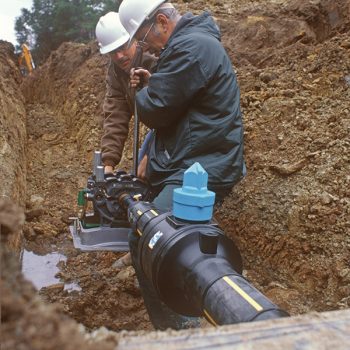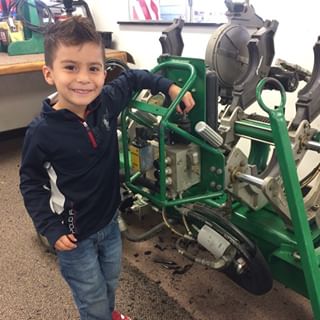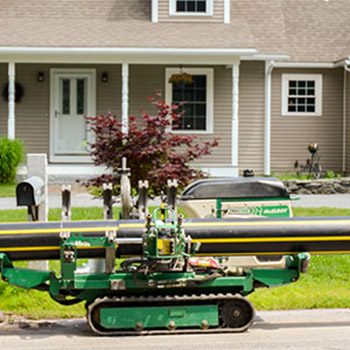Tapping into a gas line can be bothersome to local residents when their service is interrupted. Hot tapping is the process of adding pipe to an existing line without turning the flow off. The main concern with this method is safety. Protecting the environment is a priority along with the well being of crewmen during the operation. For polyethylene pipe, McElroy Manufacturing Inc. of Tulsa OK has answered both concerns with their tool, the Hot Tap.
I have been doing hot taps since 1976.
Recently two wells near the city of Steward Oklahoma needed to be connected to a gathering line owned by El Paso Natural Gas. Eddie Dotson of Gateway Pipeline in Meeker OK consulted Terry Silkey, Training and Development Manager of MMI, to do the hot tap on the 12″ line.
I was invited to go along to photograph the tap and write this article. Being a complete novice to this kind of work, the first thing I asked Terry as we arrived at the sight was, “What is the universal hand signal for take cover?,” assuming there must be one, like the ‘tap out’ used in ultimate fighting. He responded, “You won’t need a hand-signal you’ll just see everyone else running.” This was my main concern and I focused my attention on the probability of a footrace I knew I could win.
The Process:
Silkey fused a branch saddle onto the main line using a tool called the Sidewinder. The Sidewinder is a manually operated saddle fusion machine used for branch saddles, tapping tees and service saddle fittings onto main lines. He then fused a small piece of pipe called the nipple, onto a ball valve using a 14 fusion machine. The No 14 is capable of fusing pipe from 1″ IPS to 4″ DIPS.
The Hot Tap Tool was fused to the other side of the valve. The length of the tool was measured and the nipple trimmed to the proper length. Then the Hot Tap assembly was fused to the valve. After proper pressure testing, the No 14 was used to drive the cutter until the head bored through the main line wall. The cutter head is designed to retain the shavings and plug to keep debris from entering the main line. Once the tap was complete, the cutter was retracted and the ball valve closed. After bleeding the pressure off, the tool head was cut off just ahead of the gland fitting and the service line fused to the valve. Finally the valve was opened and the job complete, without ever interrupting the flow of gas.
Insight:
“I have been doing hot taps since 1976,” said Silkey. “The hot tap procedure is safe as long as the operator follows the PE manufactures fusion guidelines and uses properly designed and well maintained fusion equipment.”
Summation:
Silkey made the job look easy and safe. Only once during the job did I feel my rabbit blood begin to rise when I noticed Silkey had a concerned look on his face. It turned out to be lunchtime.


